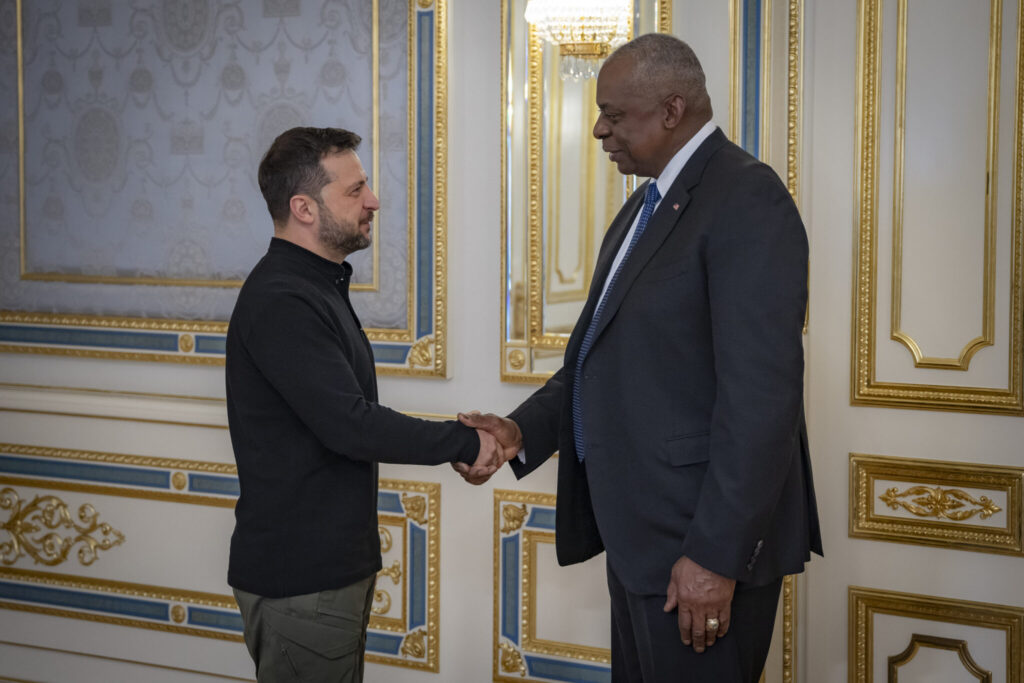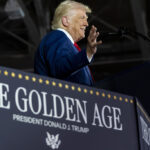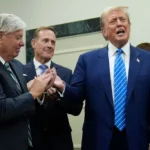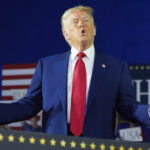Ukraine/ Russia/ Lloyd Austin/ U.S. defense support/ Russian strikes/ Zelenskyy/ NATO/ Kryvyi Rih/ Zaporizhzhia/ Newslooks/ KYIV/ Ukraine/ J. mansopur/ Morning Edition/ U.S. Defense Secretary Lloyd Austin made a surprise visit to Kyiv, reaffirming U.S. support for Ukraine amid intensifying Russian attacks. Austin’s visit comes as Ukrainian President Zelenskyy pushes for greater Western military assistance to bolster defense efforts. The trip underscores the urgent need for ammunition and weapons as Ukraine grapples with Russian missile strikes in cities like Zaporizhzhia and Kryvyi Rih.
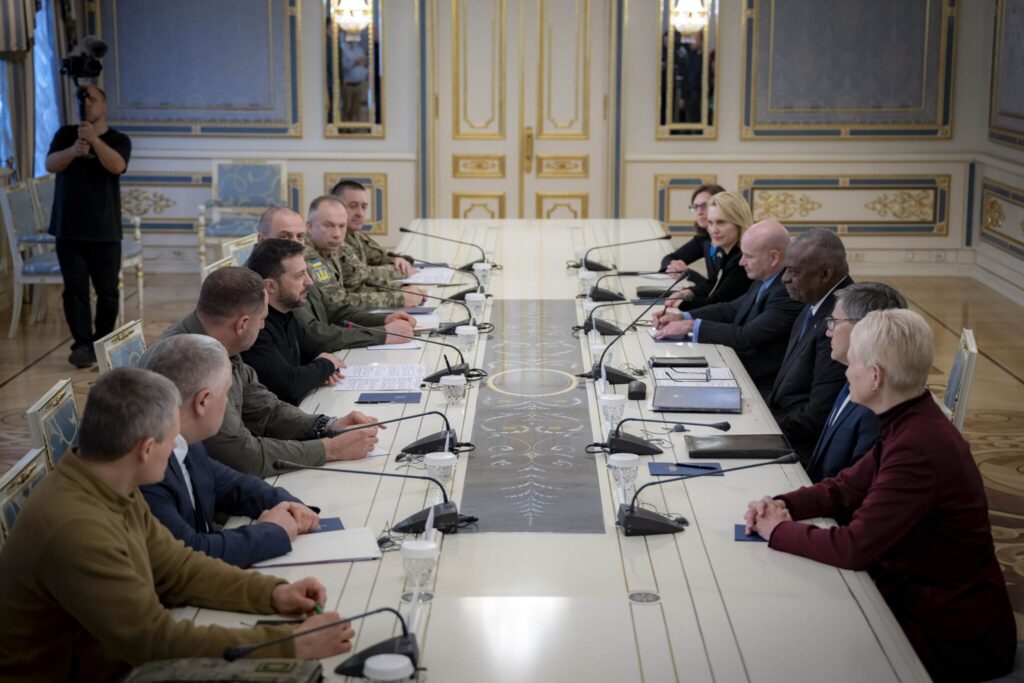
U.S. Defense Chief Visits Kyiv: Quick Looks
- Lloyd Austin visits Kyiv to discuss continued U.S. military support amid growing Russian pressure.
- Ukraine’s President Zelenskyy pushes a “victory plan” that includes NATO membership and long-range missile support.
- Russia launched new missile strikes on Zaporizhzhia and Kryvyi Rih, injuring multiple civilians.
- Austin’s visit signals ongoing U.S. commitment but no major decisions are expected before the U.S. presidential election.
- Ukraine’s Foreign Minister met with Turkish officials to discuss defense and Black Sea grain exports.
US Defense Chief Visits Kyiv Amid Ongoing Russian Strikes
Deep Look:
U.S. Defense Secretary Lloyd Austin made an unannounced visit to Kyiv on Monday, arriving shortly after Russian drone and missile attacks struck multiple Ukrainian cities, including the capital. Austin’s visit underscores the United States’ ongoing military support for Ukraine as President Volodymyr Zelenskyy continues to call on Western allies to step up their assistance in the nearly three-year-long war.
In a post on the X platform, Austin emphasized that the U.S. remains committed to standing by Ukraine during this critical time. “This visit shows that the United States, alongside the international community, continues to stand by Ukraine,” he said. It was his fourth trip to Kyiv since the conflict began.
Zelenskyy has been pushing his so-called “victory plan” with key Western allies, a strategy aimed at securing critical military resources to regain territory lost to Russian forces. His plan includes a formal invitation for Ukraine to join NATO, along with permission to use Western long-range missiles to strike Russian military targets. While some European allies like France and Lithuania have shown support, the overall Western response has been cautious.
Zelenskyy said that the plan had gained backing from “many other allies” in the European Union, but the key player in this equation remains the United States, Ukraine’s largest supplier of military aid. Although Zelenskyy noted “very positive signals” from the U.S., he stopped short of confirming whether Washington had fully endorsed his plan.
Analysts believe that a final decision from the U.S. is unlikely until after the November 5 U.S. presidential election, which could influence the future course of American policy toward the war. In the meantime, Austin’s discussions in Kyiv are expected to focus on securing continued military support, including critical ammunition supplies that Ukraine urgently needs to sustain its efforts against Russia.
Increasing Russian Attacks
Austin’s visit came just hours after a wave of Russian missile and drone strikes hit several Ukrainian cities, further highlighting the country’s pressing need for continued Western military aid. In the southern city of Zaporizhzhia, a missile attack injured 14 people and caused severe damage to civilian infrastructure, including a kindergarten and dozens of residential buildings. The strike underscored the devastating toll of the war on civilian life, even as both sides remain locked in fierce combat along the eastern front.
Meanwhile, Kryvyi Rih, President Zelenskyy’s hometown, faced its third consecutive day of missile attacks. The latest ballistic missile strike injured five people and damaged critical infrastructure, bringing the total number of injured to 21 over the past three days. Ukrainian officials described the attacks as part of Russia’s escalating campaign to pressure Ukrainian forces into retreating from contested territories.
Ukraine’s Air Force reported that Russian forces launched three missiles and over 100 drones in the latest barrage of overnight attacks from Sunday to Monday. Although much of the damage from falling drone debris in Kyiv was minor, the strikes underscored the continued vulnerability of civilian areas in Ukraine.
Strategic Talks with Turkey
As Ukraine continues to manage the immediate pressures of the war, diplomatic efforts are also underway to strengthen strategic alliances. Ukraine’s Foreign Minister, Andrii Sybiha, met with Turkish Foreign Minister Hakan Fidan in Ankara on Monday. Their talks focused on deepening defense cooperation and addressing global food security, particularly in relation to Black Sea grain shipments.
The Black Sea remains a crucial corridor for Ukraine’s grain exports, which pass through Turkey’s Bosphorus Strait. This vital trade route has been under constant threat due to Russia’s blockade of Ukrainian ports. Turkey has played a delicate balancing act throughout the conflict, maintaining close ties with both Ukraine and Russia while also offering to host peace talks between the two countries.
Turkish President Recep Tayyip Erdogan, who has positioned himself as a potential mediator, has emphasized the need for a peaceful resolution. Erdogan’s NATO-member nation is a significant player in regional diplomacy, and his involvement is seen as critical to managing tensions in the Black Sea region. However, with no clear path to peace in sight, Ukraine continues to rely on Western military assistance to hold its ground against Russian advances.
Conclusion:
Lloyd Austin’s visit to Kyiv underscores the U.S.’s enduring support for Ukraine as it faces renewed Russian missile strikes and an increasingly difficult battle along the eastern front. While Zelenskyy pushes for more robust military backing, particularly from the United States, Austin’s trip highlights the continued coordination between Kyiv and its allies. However, major decisions regarding future military aid may depend on the outcome of the upcoming U.S. presidential election, leaving the future course of the war uncertain.

